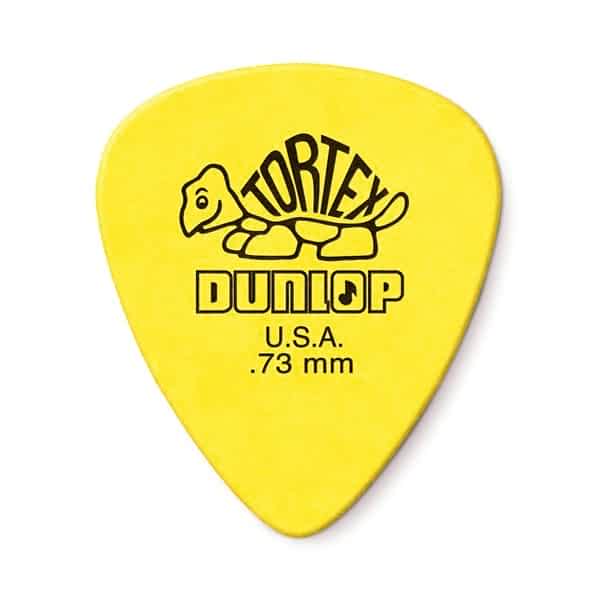Best
Overall Guitar Pick
-
Overall: Offers A Bright And Snappy Attack
-
Best Feature: Has A Grip-Enhancing Surface For Playing With Total Control
-
TedScore™: 9/10
Best
Budget Guitar Pick
-
Overall: Long-Lasting And High Quality
-
Best Feature: Made From Super-Robust Delrin
-
TedScore™: 8/10
Best
Durability Guitar Pick
-
Overall: Incredible Grip Delivered From A V-Shaped Cutout
-
Best Feature: Has A Thick Design For Creating Classic, Rich Tones
-
TedScore™: 8/10
Using a guitar pick reshapes the way you strum and pluck those strings, unlocking a world of music magic. Imagine transforming your sound like a wizard casting a spell. Whether you’re going for a heavy metal riff or soft acoustic harmonies, the right pick makes a massive difference. Did you know that thinner picks often help beginners ease into smoother playing? Plus, using a pick can boost your speed by up to 25 percent. That’s like turbocharging your tunes! Picture this: a pick is the wand in your hand, and you’re about to make those strings sing like never before. Dive in and discover how this tiny tool becomes your secret to captivating music, making every chord feel new. Curious to explore this musical adventure further? Let’s strum along the journey to guitar greatness!
It’s a small tool that greatly affects control, speed, and sound. Whether you’re new to guitar or want to improve your playing style, learning the right techniques can help you become a better guitar player.
When I first started playing, I was surprised by how many different picks there are—they come in various sizes, shapes, and weights. Holding the pick correctly can make strumming and soloing feel easy and natural.
In this article, we’ll share tips on picking the right pick, holding it for maximum comfort, and some simple strumming patterns to get you started. Let’s take your guitar skills to the next level!
What is a Guitar Pick?
If you’re new to playing the guitar, you might wonder what a guitar pick is. A guitar pick, also known as a plectrum, is a small, thin tool that guitar players use to strum or pluck strings of their instrument. It’s typically made of materials like plastic, felt, or metal.
The pick allows for more precise playing and produces a brighter, crisper sound than just your bare fingers can. It’s a versatile tool that can adapt to different genres and styles of music.
Benefits of Using Guitar Picks
Using a guitar pick offers several advantages, including increased accuracy, volume, and versatility. A pick allows for more precise picking and strumming, improving accuracy and a louder, more consistent sound.
Additionally, a pick can help reduce strain on your hands and fingers and prevent injury. With different types of picks available, you can experiment to find the one that best suits your playing style and desired sound.
Regardless of your skill level, using a guitar pick can be a valuable and fantastic tool for improving your guitar playing and achieving your musical goals.
Different Types of
Guitar Picks

Flat Picks
Flat picks are the most common type of guitar pick. They’re flat, triangular-shaped, and come in various sizes and thicknesses. The material used for flat picks can vary from plastic to metal, wood, or stone. The thickness of the pick will affect the tone and volume produced. Thicker picks have a louder, more defined sound, while thinner picks are more flexible and create a softer sound.
Flat picks are versatile and can be used for various playing styles, including strumming and hybrid picking. They are also suitable for playing different genres, such as rock, blues, and country.
Thumb Picks
Thumb picks are a unique type of guitar pick worn on the thumb. They’re commonly used by fingerstyle guitarists who want to achieve a more percussive sound. Thumb picks come in different sizes and materials; some are adjustable to fit different thumb sizes.
Thumb picks are ideal for playing bass notes and strumming chords simultaneously. They can also be used for playing intricate melodies and arpeggios. When using a thumb pick, it’s important to position the pick correctly to achieve the desired sound.
How to Choose Your Guitar Pick
Choosing the right guitar pick is essential to achieving the desired sound. The pick’s thickness, material, shape, and grip are all factors to consider.
Thin picks produce a brighter sound and are perfect for strumming, while thick picks produce a darker, heavier sound and are ideal for lead playing.
As for the size, medium-sized picks are versatile and work well for strumming guitar rhythms and lead playing. Different materials, such as plastic, nylon, celluloid, and metal, each have their own unique feel and sound.
The shape of the pick affects how it feels in your hand and strikes the sound hole in your guitar.
Some picks have textured or rough surfaces to help with a firm grip. Trying out different options is the best way to find the pick that works best for you.
So, don’t be afraid to experiment and have fun!
Importance of Holding a Guitar Pick Properly
Holding a guitar pick correctly is crucial to producing a clean and crisp sound while playing the guitar. Proper technique can also make playing complex rhythms and faster pieces easier. Holding your pick correctly can give you better control over your strumming and picking to play guitar well, leading to a more consistent sound.
Additionally, it can help reduce fatigue and discomfort by preventing unnecessary strain on your hand and wrist.
How you hold your pick can also affect the tone of individual notes on your guitar. Practising and perfecting your technique can produce a brighter and more vibrant tone.
Steps for Using a Guitar Pick When Playing
Using a guitar pick can be tricky at first, but it can become second nature with practice. Here are some steps to follow to help you get started:
Hold the pick correctly by sliding it between your thumb and the middle of your index finger. Keep a relaxed grip on your pick with the pointed end sticking away from your hand. Find a grip that works for you and emphasizes control, tone, and comfort.
Position your picking hand on the guitar’s body, with your wrist slightly above the strings. This will give you more control over the pick’s movement and help you strum or pick the strings more efficiently.
Start slow: Begin by practising simple strumming patterns, starting with downstrokes only. Once you feel comfortable with downstrokes, try adding upstrokes to your strumming pattern.
Practice alternate picking: Alternate picking is when you pick the strings in a back-and-forth motion, using both downstrokes and upstrokes. This technique can help you play faster and more accurately.
Experiment with different pick thicknesses: Different pick thicknesses can produce different sounds. Try using thinner picks for lighter and thicker for heavier strumming or picking.
What Not to Do When Using a Guitar Pick
When it comes to using a guitar pick, there are a few things you should avoid doing if you want to achieve the best sound possible.
First and foremost, don’t hold the pick too tightly. This can cause unnecessary tension in your hand and wrist, leading to fatigue and discomfort.
Of course, also don’t hold the pick too loosely, as this can cause it to slip out of your hand and affect your playing.
Another mistake to avoid is using the wrong part of the pick. Ensure you use the pointed end to strike the strings rather than the rounded edge.
Finally, don’t be afraid to experiment with different string picks and techniques until you find what works best for you.
The Best Guitar Picks We Recommend
Dunlop 0.73mm Tortex Standard Pick
The Dunlop 0.73mm Tortex Standard Pick is popular among guitarists for its versatility, durability, and comfortable grip. Made from high-quality Tortex material, these picks offer a balanced combination of flexibility and stiffness, allowing for precise control and a smooth, consistent attack across various playing styles.
Dunlop 0.73mm Tortex Standard Pick

FEATURES: Has a grip-enhancing matte surface for playing with total control
OTHER INFO: Offers a bright and snappy attack
- Made from durable Delrin for countless use in performance
- The best-selling Tortex pick line from industry giants, Jim Dunlop
- Its matte finish is useful for players who tend to sweat or have trouble holding onto picks
- Some users may find it too thin or flexible for their playing style
When you click ‘Check Price’, you’ll see there are loads of great places to buy this item. Our personal favorite is Sweetwater for the US, and Thomann and Gear4Music for the UK & Europe.
They are the largest music retailers, with excellent customer service, competitive prices, really fast shipping, and the longest guarantees.
The professional musician who wrote this article combined many things,
from the product build, manufacturer’s reputation through to feedback
from other users, to create our famous TedScore™.
Fender F Grip 351 Picks
Fender F Grip 351 Picks are a high-quality, versatile option for guitarists seeking a comfortable, secure grip and a bright, articulate tone. These picks feature a textured surface and a contoured edge that enhances control and reduces slippage, even during fast, intricate playing.
Made from durable celluloid material in a classic 351 shape, Fender F Grip Picks are available in various thicknesses to suit different playing styles and preferences, making them a reliable choice for acoustic and electric guitar players.
Fender F Grip 351 Picks

FEATURES: With lightweight celluloid design to let you play riffs faster than ever
OTHER INFO: Has a stylish shell finish to make you stand out from the crowd
- Adds a well-balanced treble tone to your overall resonance
- Enhances your live performance with ultimate precision
- Allows you to play faster, upbeat songs with complete ease
- Some users reported that the picks are too thick and don't provide enough grip
When you click ‘Check Price’, you’ll see there are loads of great places to buy this item. Our personal favorite is Sweetwater for the US, and Thomann and Gear4Music for the UK & Europe.
They are the largest music retailers, with excellent customer service, competitive prices, really fast shipping, and the longest guarantees.
The professional musician who wrote this article combined many things,
from the product build, manufacturer’s reputation through to feedback
from other users, to create our famous TedScore™.
Dunlop Kirk Hammett Custom Jazz III Picks
Dunlop Kirk Hammett Custom Jazz III Picks are designed in collaboration with the legendary Metallica guitarist to meet the demands of fast, precise playing. These picks feature a small, pointed tip that offers excellent control and accuracy for intricate lead work and tight rhythms, while the contoured grip and matte finish provide a secure, comfortable hold.
Dunlop Kirk Hammett Custom Jazz III Picks

FEATURES: Incredible grip delivered from a V-shaped cutout
OTHER INFO: Has a thick design for creating classic, rich tones
- Offers incredible speed, precision, and control for an enhanced playing
- Can handle any performance
- Makes you feel like a rockstar, courtesy of Metallica's Kirk Hammett and Dunlop
- May not be suitable for players who have difficulty handling smaller picks
When you click ‘Check Price’, you’ll see there are loads of great places to buy this item. Our personal favorite is Sweetwater for the US, and Thomann and Gear4Music for the UK & Europe.
They are the largest music retailers, with excellent customer service, competitive prices, really fast shipping, and the longest guarantees.
The professional musician who wrote this article combined many things,
from the product build, manufacturer’s reputation through to feedback
from other users, to create our famous TedScore™.
Ernie Ball Everlast, 0.60mm Picks
Ernie Ball Everlast, 0.60mm Picks, is a durable, long-lasting choice for guitarists who demand consistency and reliability from their accessories. The 0.60mm thickness offers a balanced mix of flexibility and control, making Everlast Picks suitable for a wide range of playing styles and genres, from strumming to single-note picking on acoustic and electric guitars.
Ernie Ball Everlast, 0.60mm Picks

FEATURES: Long-lasting and high quality
OTHER INFO: Made from super-robust Delrin
- With a medium-light, 0.60mm thickness for shimmering strummed chords
- Ergonomic and responsive
- The perfect pick that gives you the control you need
- May be too thin or flexible for some users' preferred playing styles
When you click ‘Check Price’, you’ll see there are loads of great places to buy this item. Our personal favorite is Sweetwater for the US, and Thomann and Gear4Music for the UK & Europe.
They are the largest music retailers, with excellent customer service, competitive prices, really fast shipping, and the longest guarantees.
The professional musician who wrote this article combined many things,
from the product build, manufacturer’s reputation through to feedback
from other users, to create our famous TedScore™.
Dunlop 0.60mm Nylon Standard Picks
Dunlop 0.60mm Nylon Standard Picks are a versatile and reliable choice for guitarists seeking a balanced combination of flexibility and durability. Made from high-quality nylon material, these picks offer a smooth, consistent attack and a warm, rounded tone that suits both strumming and single-note playing.
The 0.60mm thickness provides a comfortable, medium gauge for good control and precision, making these picks an excellent all-around choice for acoustic and electric guitar players of various skill levels and musical styles.
Dunlop 0.60mm Nylon Standard Picks

FEATURES: Made from a super sturdy nylon material
OTHER INFO: Offers a crisp, detailed tone and unrivalled articulation
- Has a moulded surface for a superior grip and precise performance
- With a pro-ready design to enhance your tone
- Robust and reliable nylon pick
- Created with world-renowned Dunlop quality
- Lacks the necessary weight and grip for heavier playing styles
When you click ‘Check Price’, you’ll see there are loads of great places to buy this item. Our personal favorite is Sweetwater for the US, and Thomann and Gear4Music for the UK & Europe.
They are the largest music retailers, with excellent customer service, competitive prices, really fast shipping, and the longest guarantees.
The professional musician who wrote this article combined many things,
from the product build, manufacturer’s reputation through to feedback
from other users, to create our famous TedScore™.
How To Use Guitar Picks
Summary
Learning how to use a pick on a guitar seems daunting at first, but with practice, it becomes second nature.
Here’s a nifty breakdown of what we covered:
- Holding the Pick: Use a relaxed grip between your thumb and index finger.
- Positioning: Angle the pick slightly for efficient strumming.
- Strumming and Picking: Let the motion come from your wrist, with your arm moving naturally.
Remember, consistency is key. Keep practicing and experimenting with different holds and techniques, and soon, you’ll find what works best for you.
Happy playing!
But hang on – if you’re interested in how to use a pick, you might be interested in reading our article Best Guitar Picks For Beginners.
FAQ's
For beginner guitarists, using a guitar pick can be helpful in developing your technique and achieving a consistent sound. While it may take some practice to get used to, using a pick can make it easier to play certain styles of music and create a brighter, more vibrant tone for beginning guitarists.
Yes, there’s a proper way to hold a guitar pick. You should hold the pick between your thumb and index finger, with the pointed end facing the guitar strings. Hold the pick perpendicular to it loosely enough to allow for flexibility but not so loosely that it slips out of your strumming hand.
Thumb picks and flat picks serve different purposes when playing guitar. Thumb picks are ideal for fingerpicking and playing bass notes, while flat picks are better for strumming and playing lead guitar.
Yes, you can use a quarter as a guitar pick in a pinch, but it is not recommended as it can damage the strings and the guitar. Additionally, quarters are not designed for playing guitar and can produce a harsh, metallic sound.
Yes, you can play a classical guitar with a pick, but it is not recommended as it can damage the strings and the guitar. Classical guitars are typically played with the fingers using a technique called fingerstyle playing.











Loved the section on holding the pick properly! It’s something so basic yet easily overlooked. I’ll be passing these tips onto my students. Good job on highlighting that, Hugh Richardson.
While I appreciate the effort to shed light on the use of guitar picks, I can’t help but notice a critical oversight in your selection. As a guitarist with over a decade of experience, I’ve found that the texture and grip of a pick can drastically affect playability and tone, yet these facets seem underrepresented in your recommendations. Picks like the Dunlop Tortex and Fender F Grip cater to these attributes, but what about picks designed for precision or those made from unique materials that alter the tone? I believe a more comprehensive guide should not only address thickness or brand but delve deeper into how the physical properties of a pick can influence a guitarist’s sound and technique.
hey, i just started learning guitar and reading about all these different picks is kinda overwhelming. do u think i should go with something like the dunlop .60mm nylon standard picks for starters? they sound easy enough to handle.
I’m really glad I came across this article. I’ve been playing guitar for a couple of years now, but never really gave much thought to the type of pick I use. Seeing the section on different types of guitar picks and how to choose got me thinking I might be missing out on improving my play. Gonna try out some of the picks you recommended, especially the Dunlop Kirk Hammett ones since Metallica is a huge influence for me. Cheers for the insight, Hugh Richardson.
Metallica and picks, name a more iconic duo. Go on, I’ll wait. 🙂
Those Kirk Hammett picks are a game changer, especially if you’re into fast solos. Good choice!